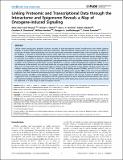Linking Proteomic and Transcriptional Data through the Interactome and Epigenome Reveals a Map of Oncogene-induced Signaling
Author(s)
Huang, Shao-shan Carol; Clarke, David C.; Gosline, Sara Jane Calafell; Labadorf, Adam; Chouinard, Candace R.; Gordon, William; Lauffenburger, Douglas A.; Fraenkel, Ernest; ... Show more Show less
DownloadHuang-2013-Linking Proteomic an.pdf (1.764Mb)
PUBLISHER_CC
Publisher with Creative Commons License
Creative Commons Attribution
Terms of use
Metadata
Show full item recordAbstract
Cellular signal transduction generally involves cascades of post-translational protein modifications that rapidly catalyze changes in protein-DNA interactions and gene expression. High-throughput measurements are improving our ability to study each of these stages individually, but do not capture the connections between them. Here we present an approach for building a network of physical links among these data that can be used to prioritize targets for pharmacological intervention. Our method recovers the critical missing links between proteomic and transcriptional data by relating changes in chromatin accessibility to changes in expression and then uses these links to connect proteomic and transcriptome data. We applied our approach to integrate epigenomic, phosphoproteomic and transcriptome changes induced by the variant III mutation of the epidermal growth factor receptor (EGFRvIII) in a cell line model of glioblastoma multiforme (GBM). To test the relevance of the network, we used small molecules to target highly connected nodes implicated by the network model that were not detected by the experimental data in isolation and we found that a large fraction of these agents alter cell viability. Among these are two compounds, ICG-001, targeting CREB binding protein (CREBBP), and PKF118–310, targeting β-catenin (CTNNB1), which have not been tested previously for effectiveness against GBM. At the level of transcriptional regulation, we used chromatin immunoprecipitation sequencing (ChIP-Seq) to experimentally determine the genome-wide binding locations of p300, a transcriptional co-regulator highly connected in the network. Analysis of p300 target genes suggested its role in tumorigenesis. We propose that this general method, in which experimental measurements are used as constraints for building regulatory networks from the interactome while taking into account noise and missing data, should be applicable to a wide range of high-throughput datasets.
Date issued
2013-02Department
Massachusetts Institute of Technology. Cell Decision Process Center; Massachusetts Institute of Technology. Computational and Systems Biology Program; Massachusetts Institute of Technology. Computer Science and Artificial Intelligence Laboratory; Massachusetts Institute of Technology. Department of Biological EngineeringJournal
PLoS Computational Biology
Publisher
Public Library of Science
Citation
Huang, Shao-shan Carol et al. “Linking Proteomic and Transcriptional Data Through the Interactome and Epigenome Reveals a Map of Oncogene-induced Signaling.” Ed. William Stafford Noble. PLoS Computational Biology 9.2 (2013): e1002887.
Version: Final published version
ISSN
1553-734X
1553-7358